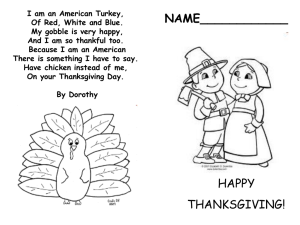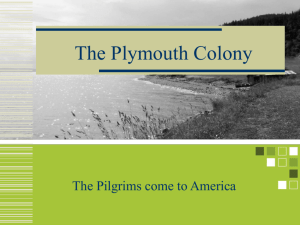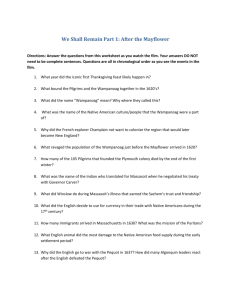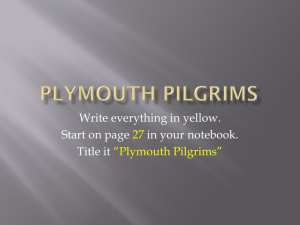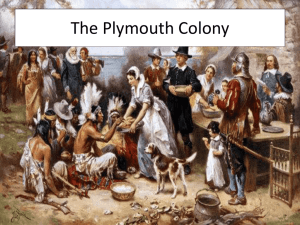Love
advertisement
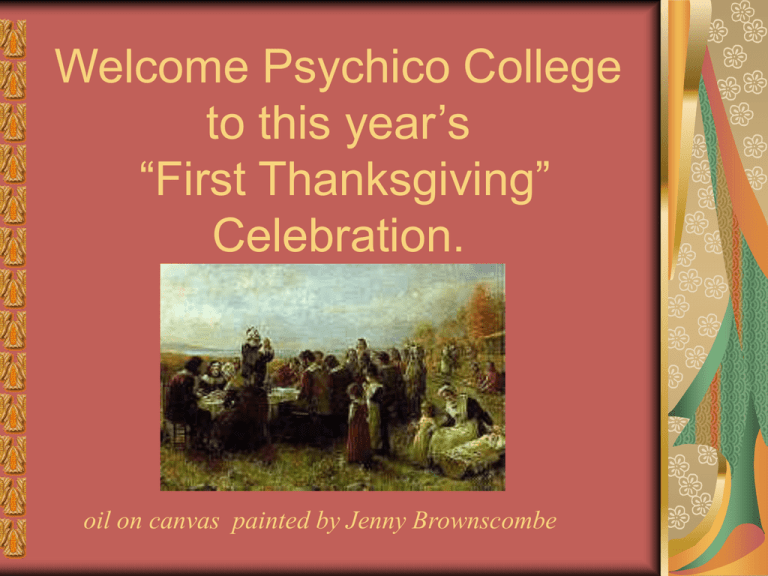
Welcome Psychico College to this year’s “First Thanksgiving” Celebration. oil on canvas painted by Jenny Brownscombe Artist /Band: Black Eyed Peas Song Title: Where Is The Love? What's wrong with the world, mama People livin' like they ain't got no mamas I think the whole world addicted to the drama Only attracted to things that'll bring you trauma Overseas, yeah, we try to stop terrorism But we still got terrorists here livin' In the USA, the big CIA The Bloods and The Crips and the KKK But if you only have love for your own race Then you only leave space to discriminate And to discriminate only generates hate And when you hate then you're bound to get irate, yeah Badness is what you demonstrate And that's exactly how anger works and operates Now, you gotta have love just to set it straight Take control of your mind and meditate Let your soul gravitate to the love, y'all, y'all People killin', people dyin' Children hurt can you hear them cryin'? Can you practice what you preach? And would you turn the other cheek? Father, Father, Father help us Send us some guidance from above 'Cause people got me, got me questionin' Where is the love? (Love) Where is the love? (The love) Where is the love? (The love) Where is the love? The love, the love It just ain't the same, always unchanged New days are strange, is the world insane? If love and peace is so strong Why are there pieces of love that don't belong Nations droppin' bombs Chemical gasses fillin' lungs of little ones With the ongoin' sufferin' as the youth die young So ask yourself is the lovin' really gone So I can ask myself really what is goin' wrong In this world that we livin' in people keep on givin' in Makin' wrong decisions, only visions of them dividends Not respectin' each other, deny thy brother A war is goin' on but the reason's undercover The truth is kept secret, it's swept under the rug If you never know truth then you never know love Where's the love, y'all, come on (I don't know) Where's the truth, y'all, come on (I don't know) Where's the love, y'all( come on yeah) People killin', people dyin' Children hurt can you hear them cryin'? Can you practice what you preach? And would you turn the other cheek? Father, Father, Father help us Send us some guidance from above 'Cause people got me, got me questionin' Where is the love? (Love) Where is the love? (The love) Where is the love? (The love) Where is the love? The love, the love I feel the weight of the world on my shoulder As I'm gettin' older, y'all, people gets colder Most of us only care about money makin' Selfishness got us followin' the wrong direction Wrong information always shown by the media Negative images, it's the main criteria Infecting the young minds faster than bacteria Kids want to act like what they see in the cinema Yo', whatever happened to the values of humanity? Whatever happened to the fairness in equality? Instead in spreading love we're spreading animosity Lack of understanding, leading lives away from unity That's the reason why sometimes I'm feelin' under That's the reason why sometimes I'm feelin' down There's no wonder why sometimes I'm feelin' under (so ask yourself) Gotta keep my faith alive till love is found People killin', people dyin' Children hurt can you hear them cryin'? Can you practice what you preach? And would you turn the other cheek? Father, Father, Father help us Send us some guidance from above 'Cause people got me, got me questionin' Where is the love? (Love) Where is the love? (The love) Where is the love? (The love) Where is the love? The love, the love Welcome Psychico College to this year’s “First Thanksgiving” Celebration. oil on canvas painted by Jenny Brownscombe Today we will relive the Pilgrims' first year in America, and learn how the Wampanoag helped them survive in the New World. Now let’s start the timeline… The story of the Pilgrims and the Wampanoag begins before the Thanksgiving feast. PHOTOS BY Russ Kendell September–November 1620: The Mayflower Voyage The Pilgrims left Plymouth Harbor in England on a ship called the Mayflower and headed towards America. They sought religious freedom there to worship the way they wanted. They did not have this right in England because their government had restricted their choice of religious beliefs. That is why they asked for permission to settle in America. Their voyage was difficult, but miraculously only one of the 102 passengers died. November 1620–February 1621: The First Days of Plymouth Images by Dr. Mike Haywood (used with permission) The Mayflower's destination was northern Virginia, but the ship was thrown off course by a storm. Did you know? During this storm John Howland fell overboard. Luckily he survived and arrived safely in New England. Did you know? Elizabeth Hopkins and her husband travelled on the Mayflower. While at sea, Elizabeth gave birth to their son Oceanus. November 1620–February 1621: The First Days of Plymouth On December 11th the Mayflower landed at Plymouth and the settlers decided to stay. The Pilgrims' first winter was very difficult. When it started to snow, they had not yet built enough houses. Therefore, many Pilgrims sought shelter aboard the Mayflower. They all suffered from the bitter cold and lack of food. Unfortunately, only half of them survived. However, when the Mayflower sailed back to England in April, all of the Pilgrims chose to stay in America. Did you know? Priscilla Mullins travelled on the Mayflower with her parents, her brother, Joseph, and a servant, Robert Carter — all of whom died during the first winter in Plymouth. During all this time however, the Pilgrims were not alone. A group of people called the Wampanoag were already living in the Plymouth area. March 1621: The Pilgrims & the Wampanoag Meet One day a Native American named Samoset walked into the Plymouth colony and said “Welcome Englishmen”. This really surprised them. He had learned some English from some European fishermen. He introduced the Pilgrims to the Wampanoag leader Chief Massasoit and another Indian named Squanto. Squanto also spoke English and acted as their guide and interpreter. The two groups so as to avoid any conflict exchanged gifts and signed the "Treaty of Friendship”. During this time the Wampanoag shared their knowledge of hunting, fishing and farming with the Pilgrims. The Pilgrims invited the Indians to celebrate their first harvest in 1621, an event now celebrated as Thanksgiving Day. In 1621 a Wampanoag named Hobbamock moved in with his family into the Plymouth settlement. Shortly after, Chief Massasoit and Squanto were captured by another native tribe, the Narraganset. The Pilgrims sent 10 men to confront the Narraganset. Chief Massasoit and Squanto were released. This event is an example of how the Wampanoag and the Pilgrim communities had been changed by their friendship and cooperation. CLOTHES CLOTHES CLOTHES FOOD FOOD HOUSES HOUSES LEARNING LEARNING CHORES CHORES GAMES GAMES October 1621: The first Harvest Feast Plymouth Governor William Bradford declared a feast to give thanks to God for their first harvest. Massasoit and 90 other Wampanoag were invited to join the 52 Pilgrims for this three-day feast. The English served wild turkeys, geese, and ducks… The Wampanoag brought five deer, along with lobsters, clams, oysters, and fish. Source: Kathleen Curtin, Food Historian at Plymouth Plantation All Photos Courtesy of Plymouth Plantation, Inc., Plymouth, MA. USA Did you know? William Brewster served as an elder of the Separatist church in Holland. He was the religious leader of Plymouth for many years. After 1621 More English people arrived at Plymouth. They began settling in other areas nearby. Sometimes the English gave the Native Americans beads or tools in exchange for the land. The natives found this odd as they believed that the land belonged to everyone and could not be owned. They still hold this belief today. After Chief Massasoit's death, the Wampanoag joined other tribes and tried to eliminate settlers. As a result of this war the Wampanoag were nearly exterminated. The colony gradually grew in size, and the original settlement known as the Plymouth Plantation expanded as settlers built more houses in the area. By 1691 its population exceeded 7,000. Sadly however, only a small number of Wampanoag still live in this area today. “Thanksgiving” – by Alan Gordon An interview with Mr. Fast Turtle NOTE: The fictionalized character of Fast Turtle is portrayed by Russell Peters, a present-day Wampanoag. PSYCHICO COLLEGE CHANNEL presents Common Thanksgiving Myths James W. Baker says: “Thanksgiving is an invented tradition, and that’s why we have so many myths about it. It doesn’t originate from one event, but it is a mix of several minor festivities, which all blend in to one big festival!” Myth: The first Thanksgiving festival was in 1621 and the Pilgrims celebrated it every year thereafter. Fact:The first feast wasn't repeated, so it wasn't the beginning of a tradition. In fact, the colonists didn't even call the day Thanksgiving. Myth: The original thanksgiving feast took place on the fourth Thursday of November. Fact:The first feast in 1621 occurred sometime between September and November. Unlike our modern holiday, it was three days long. Myth: The Pilgrims wore only black and white clothing. They had buckles on their hats, garments, and shoes. Fact: Buckles did not come into fashion until later in the seventeenth century and black and white were commonly worn only on Sunday and on formal occasions. Myth: The Pilgrims brought furniture with them on the Mayflower. Fact: The Pilgrims only brought chests and boxes with them on the Mayflower. Other furniture, either beds or tables, would have been thoroughly impractical on board. They made that kind of furniture once they settled in Plymouth. Myth: The Mayflower was heading to Virginia, but due to a navigational mistake it ended up in Cape Cod Massachusetts. Fact: The Pilgrims were actually planning to settle in Virginia, but not the modernday state of Virginia. The Pilgrims had intended to go to the State of New York, which would have been considered "Northern Virginia," but they landed in Cape Cod instead. Thank you everyone! We are all united in our common heritage. See you next year!

